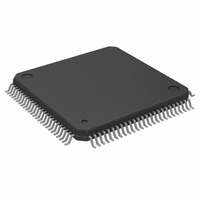SLXT914QC.B3 Intel, SLXT914QC.B3 Datasheet - Page 23

SLXT914QC.B3
Manufacturer Part Number
SLXT914QC.B3
Description
IC QUAD ETHERNET REPEATER 100QFP
Manufacturer
Intel
Type
Repeaterr
Datasheet
1.NLXT914PC.B3.pdf
(45 pages)
Specifications of SLXT914QC.B3
Rohs Status
RoHS non-compliant
Tx/rx Type
Ethernet
Voltage - Supply
4.75 V ~ 5.25 V
Current - Supply
180mA
Mounting Type
Surface Mount
Package / Case
100-QFP
Delay Time
-
Capacitance - Input
-
Other names
831521
Available stocks
Company
Part Number
Manufacturer
Quantity
Price
2.7
2.8
2.9
Datasheet
Note: If LED mode 0 is selected and the LEDJM/AUISEL pin is High (which selects MAU Mode), the
Collision Handling
A collision occurs when two or more repeater ports receive simultaneously, or when the AUI CIP/
CIN signal is active. The LXT914 Repeater fully complies with the IEEE 802.3 collision
specifications, both in individual and multi-repeater applications. In multiple-repeater
configurations, collision signaling on the IRB allows all repeaters to share collision parameters,
acting as a single large repeater.
IRCOL is a digital open-drain pin. IRCFS is an analog/digital port. The IRCOL and IRCFS lines
are pulled up globally (i.e., each signal requires one pull-up resistor for all boards). If there are
eight 3-repeater boards in the system, all eight boards share a single pull-up resistor for IRCOL and
a single pull-up resistor for IRCFS. The global pull-up may be located on one of the boards, or on
the backplane. The IRCFS line requires a precision (± 1%) resistor.
The IRENA, IRDAT and IRDEN lines are each pulled up locally (one pull-up resistor per board) if
external bus drivers are used. If no bus drivers are used then only one global pull-up per signal is
used.
Security Mode
The LXT914 Repeater security mode is fully transparent to the user. In the External management
mode, the security feature is available for all four TP ports and the AUI port. In the Local mode,
security is available for the TP ports only (the SECAUI input is reassigned as FPS). The security
inputs are normally held Low to disable the security feature. Any input can independently be pulled
High to scramble the respective port for any given length of time. For applications which do not
require security control, the SEC pins must be tied Low.
The security mode pins are real time response inputs. This allows the board designer to screen the
destination address with an application specific device and (on match of the destination address) to
assert the security input to jam the respective port for the given frame. This real time detection and
jam assertion method provides the flexibility to implement customer specific solutions. The
destination address decoding and security signal assertion functions can be integrated into the
external management device.
LED Display
The LED display interface consists of seven integrated LED drivers, one for each of the five
network ports and two for common functions. Each pin provides a three-state pulsed output (+5 V,
high Z, and 0 V) which allows multiple conditions to be monitored and reported independently.
Table 14
shows the LED Driver output conditions, and
associated with each of the five conditions.
device defaults to LED Mode 1. LED Mode 0 is not available when LEDJM/AUISEL is pulled
High.
shows the LED Mode selected with each LEDM1 and LEDM0 combination.
Intel
®
Order Number: 248989, Revision: 003
LXT914 Flexible Quad Ethernet Repeater
Table 15
Intel
through
®
LXT914 Flexible Quad Ethernet Repeater
Table 18
list the repeater states
Figure 5
31-Oct-2005
23












